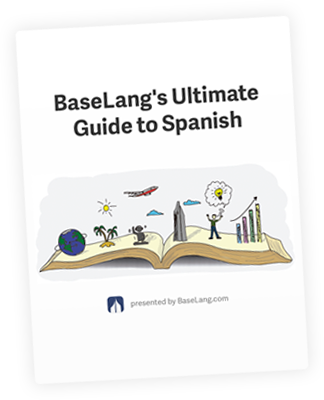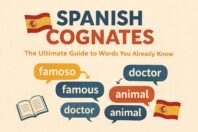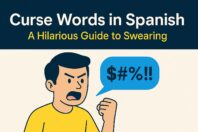How To Learn Spanish Vocabulary: A Blueprint For Success

Get our free email course, Shortcut to Conversational.
Have conversations faster, understand people when they speak fast, and other tested tips to learn faster.
More infoWith the right methods, learning Spanish vocab is, minute for minute, one of the most valuable uses of your study time.
Let’s say that you are learning Spanish as a beginner. Once you have a solid base of grammar, the fastest way to unlock new topics and widen the breadth of things you can talk about is by learning new vocab.
In the intermediate stage, learning a lot of vocab is a big part of what will get you from broken sentences to conversationally-fluent.
And at the advanced stage, you’ll be learning vocab like it’s your job. So it’s with good reason that people give such weight to learning new words, and ask so many questions about how best to go about it. And being the language learning industry’s favorite topic, there are some really good tools out there to help you here.
My strategy for vocab is simple:
1. Learn the words intellectually using an SRS
2. Make using the words second nature by using them in real conversations
A word of warning before we dig into the strategy here: do NOT learn vocab until you have very good pronunciation. Your accent doesn’t need to be great, but you should be able to pronounce each word individually almost perfectly. Otherwise, you’ll end up learning a word like “disculpe” (excuse me) thinking that it sounds like “dih-scuhl-p” (wrong) instead of “dee-scool-peh” (correct).
If you end up memorizing the word with bad pronunciation, you won’t recognize it when other people use it in real speech, and the whole point of learning the word is ruined.
Seriously, nail the pronunciation first.
With that warning out of the way, back to our regular programming: learning vocab quickly and effortlessly.
The Magic Of Flashcards For Learning Spanish Vocabulary
In case you aren’t familiar with the term “SRS” or “spaced repetition system”, basically, it’s a fancy way of saying smart flashcards.
The first time you see a card, if you get it right, you’ll see it again in ten minutes. Then, if you get it right in ten minutes, you won’t see it again for a day. Then four days. Then two weeks. Then a month. Then three months. Then a year.
BUT, if you get it wrong, it goes right back to the beginning, and you see it ofen again until you can correctly recall it.
Different apps have slightly different intervals, but the psychology is the same:
1. By forcing you to recall the word just before you were about to forget it, the memory formed is much stronger
2. By reviewing things on extended intervals, you can learn 20-30 new words and manage your vocabulary of thousands of old words with only 20 minutes of work a day (or less)
Because these intervals are based on science and studies (which I won’t bore you with here, as I think this is fairly intuitive), not only are you spending less time on vocab, you’re retaining it better.
Another nice part of training with an SRS is you can do it in tiny chunks of time anywhere. Waiting in line? Get in some vocab. On public transport? Get in some vocab. On the toilet? Get in some vocab. These twenty minutes almost never add any “study time” to your day, they just make your idle time productive.
I’ll cover the how-to, including which apps I use and recommend, for this in a minute. But first let’s look at the often overlooked second half of learning vocabulary.

Download the expanded guide to read later
This page gives you a great overview of the most important concepts and strategies, but for the full, expanded guide, click the button below:
Download Guide Now!Actually Use The Words In Real Life
Let’s say you have learned a new verb with your SRS: desarrollar (to develop). You’ve studied it a few times and can always recall it. Thus, you won’t see it again for a month.
Most people stop here. But the reality is, when the flashcard comes up and you see “to develop” on the front, it still takes you a half-second to a second to remember it and say “desarrollar”.
While that sounds fairly quick, when it comes to using it in a conversation, you’ll end up with a pause before the word comes out. Your speech is going to end up all choppy and full of pauses, while you search your brain for the word.
What we want is for the word to flow out naturally, like English does, without thinking about it.
The only way to do this is to actually use it in conversations. It depends word to word. Somewhere you have a strong memory tied to the word, take less time to make second nature.
Others will take a little more brute force. But every word requires repetition and use in real conversations to become fully second nature.
This second half of the process is fairly straightforward. Just talk. A good teacher will force you to use the words if you don’t naturally yourself.
But for the first half, how should you go about structuring your learning with the SRS, and what app should you use?
How To Structure Your Spanish Flashcards
Before we dig into the technology we’ll use here, let’s discuss how to structure your cards.
The front should either have a photo of the object (for nouns that are easy to illustrate, like “tree”) or just the English. Personally, I just put English for everything as I didn’t have enough time to dig around for photos.
You should NOT put the Spanish on the front and the English on the back, ever. This is a huge mistake, as it’s training you to recognize the Spanish and understand it. If you put Spanish on the front, you’ll find yourself understanding people when they speak but being stuck when it comes time to open your own mouth.
The point of these cards is to train you to be able to produce Spanish, given only English and no hints, as this is how it works when you’re actually talking to someone. If you can produce the Spanish, you can recognize it, but not the other way around.
As for how much to study, that depends on how fast you are trying to progress. For most people, 15-20 new words a day is plenty. Remember, you’ll need to keep up with maintaining your old cards as they come back to you days, weeks, or months later, and that will take at least half of your time. This will keep your daily studying down to 15-20 minutes a day.
If you have more time and are more ambitious (make sure you want to keep up with it in the long term), increase from there.
Recommended Resources
There are two apps I recommend as your SRS. I’d pick one and just stick to it.
Anki
Available on iOS, Android, and Desktop.
AnkiSRS.net
This is what I personally prefer, as it’s simpler. You are shown the front of the card. You tap the screen (or click on your computer), and it shows the back underneath the front side. Then, you tap on the right if you got it right, or on the left if you got it wrong. Self graded and dead-simple.
It’s also very customizable in case you want to get fancy. Personally, I just use the standard, simple front/back setup and it works perfectly.
However, it’s not very pretty (rather, it’s very ugly), and there’s a bit of a steep learning curve to figure out how to use it. It’s not intuitive and you’ll likely need some tutorials and poking around to get setup.
The iOS app is $19.99 (Android and Desktop versions are free), which pays for their server costs.
It’s also not very good at gamifying the experience, which means that unlike some apps (like the one coming up), Anki isn’t playing with your psychology to get you hooked on training your vocabulary. If you feel like you may need some extra motivation to keep up with doing this daily, you’ll want to use the next option, Memrise.
Memrise
Available on iOS, Android, and their website (which works on any mobile device, too).
Memrise.com
To start, Memrise is free for all platforms. They do have a premium version, but we don’t really need it. Memrise is very easy to use, it looks good, and it’s intuitive. If you aren’t that good with technology in general, this is your pick.
Memrise does things a bit differently than Anki, but it’s based on the same principles. Early on with a word, they will show you multiple choice, as it’s easier. As you progress, they will make you type out the word fully (something we’ve opted to leave out of our BaseLang flashcards), as well as one or two other variations.
Some people will like this variation, and some will prefer a self-graded simple flashcard setup like Anki.
But what Memrise does way better than Anki (other than being easy to use and looking good) is that they have gamified things a bit. It’s not overdone, but you may find that their little concept of building words from seeds to saplings to full plants, then having to “water” your plants to keep them alive, as well as their progress bars, goals, and other simple built-in mechanisms will keep you a little more motivated to come back keep studying.
Memrise also makes adopting pre-made flashcard decks that other people have made very easy, and can save you a lot of time. Just, the first time you see the word, you’ll want to stop and make a few mental associations with it:
1. What it sounds like (say it a few times and check that you match the recording that the deck creator hopefully included – if you are using the BaseLang cards, every word has this)
2. How it’s spelled (this is pretty simple and I wouldn’t spend more than a few seconds on this)
3. Lastly, try to attach some personal meaning to the word (which is best), or a create mnemonic.
A Mnemonic is a simple memory device that ties a short but memorable sentence to the word. For instance, for “gato”, your mnemonic could be “the cats ga-toes” (the cat’s got toes). Stupid, but it will help you remember the word. Make these yourself as borrowing other people’s mnemonics don’t work as well.
The only point of this is to get you to the point of getting the word right every time, at which point you won’t need it anymore and you’ll start using speech to make the word second nature.
This step (making a mnemonic) is also optional – you don’t have to do this. But for many people, it helps – and if you get stuck with a word you can never seem to recall, this will help.
If you want to steal our flashcards, which go from complete beginner to advanced student, focusing on the most used and important words first, then just download the Perfect Spanish Curriculum Blueprint, which includes a link to our private Memrise group. It even has clear native speaker audio recordings for every word!
I hope you learned a lot from this post, as it’s the exact strategy I used to learn vocabulary for the Spanish in a Month documentary.
In fact, I wrote a 119-page guide containing the other strategies I used (that you can copy) to learn Spanish grammar, get perfect pronunciation and much more.
You can download the entire guide, for free, right below.

Download the expanded guide to read later
This page gives you a great overview of the most important concepts and strategies, but for the full, expanded guide, click the button below:
Download Guide Now!


